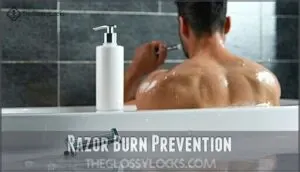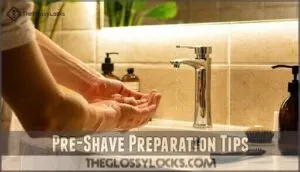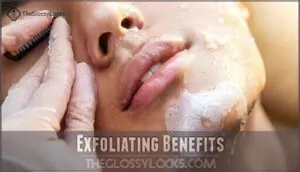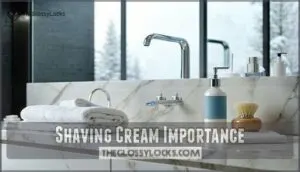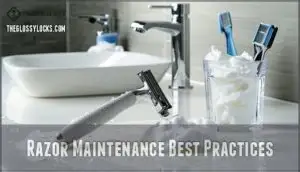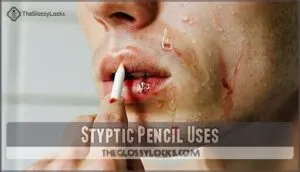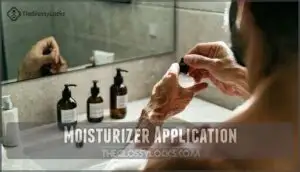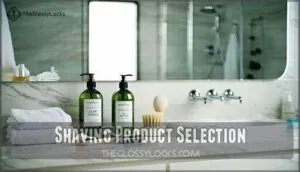This site is supported by our readers. We may earn a commission, at no cost to you, if you purchase through links.
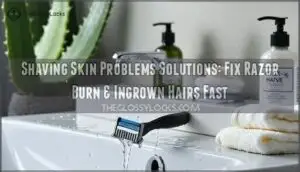
Start by replacing dull blades frequently and shaving with the grain, not against it. Use a sharp, clean razor and apply quality shaving cream to create a protective barrier.
After shaving, rinse with cold water and apply a fragrance-free moisturizer to soothe irritated skin.
For existing razor burn, try aloe vera or witch hazel for quick relief. Store your razor in a dry place to prevent bacteria buildup.
The secret lies in understanding your skin’s unique needs and timing.
Table Of Contents
- Key Takeaways
- Shaving Skin Issues
- Razor Burn Prevention
- Shaving Techniques Matter
- Preventing Irritation Tips
- Effective Shaving Solutions
- Frequently Asked Questions (FAQs)
- Are there solutions to shave problems?
- Can shaving cause skin problems?
- What are the most common shave problems?
- What causes skin irritation if you shave too much?
- How to prevent razor burn & other shaving irritations?
- Should you shave over razor bumps?
- How do you treat irritated skin from shaving?
- How do you get rid of shaving rash down there fast?
- How to fix sensitive skin when shaving?
- Does vaseline get rid of shaving rash?
- Conclusion
Key Takeaways
- Replace your razor blades every 5-7 uses – Sharp blades cut cleanly without tugging, while dull ones cause razor burn, nicks, and skin irritation that’ll make your morning routine miserable.
- Always shave with the grain, not against it – Following your hair’s natural growth direction prevents ingrown hairs and reduces friction that leads to painful razor burn and inflammation.
- Use quality shaving cream and proper preparation – Apply shaving cream to create a protective barrier, soften your hair with warm water, and exfoliate beforehand to remove dead skin cells that clog your razor.
- Moisturize immediately after shaving – Apply fragrance-free moisturizer within 30 seconds of finishing to lock in hydration, soothe irritation, and restore your skin’s protective barrier.
Shaving Skin Issues
You face several common shaving problems that can make your grooming routine uncomfortable and frustrating.
These skin issues include ingrown hairs, folliculitis barbae, razor burn, and nicks that occur when proper shaving techniques aren’t followed.
Ingrown Hair Causes
When you shave against your hair growth direction, you’re creating the perfect storm for ingrown hairs.
Shaving against the grain turns every hair follicle into a potential ingrown hair trap.
Sharp blades cut hair below skin level, while poor razor hygiene introduces bacteria that worsens inflammation.
Without proper hair softening and attention to hair angle, freshly cut hairs curl back into your skin instead of growing outward, causing painful bumps and skin irritation that proper shaving prevention techniques can easily avoid.
To prevent this, exfoliation removes dead skin, aiding hairs in breaking through the surface.
Folliculitis Barbae Symptoms
Unlike ingrown hairs that trap hair beneath skin, folliculitis barbae creates infected hair follicles with distinct warning signs.
You’ll notice these symptoms after shaving:
- Pustule Identification: Small, pus-filled bumps appear around hair follicles
- Itch Severity: Intense burning and itching sensations develop quickly
- Infection Spread: Red, swollen areas merge together across your beard
- Medical Treatment: Persistent symptoms require professional care to prevent scarring
Proper hygiene practices prevent this painful skin inflammation from recurring.
It’s often caused by Staphylococcus aureus.
Razor Burn Overview
Razor burn appears as red, irritated patches on your skin after shaving, often accompanied by burning, itching, or stinging sensations.
You’ll commonly experience these razor burn symptoms on your legs, face, neck, armpits, and pubic areas.
Don’t confuse razor burn with razor bumps, which are small, pimple-like ingrown hairs, or worry about herpes misdiagnosis since razor burn lacks fluid-filled sores.
Razor burn resolution typically occurs within days with proper care.
Nicks and Cuts Prevention
Cutting yourself while shaving isn’t just painful—it’s completely preventable with the right approach. Blade Sharpness and Lather Quality form your first line of defense, while Pressure Control and Technique Refinement keep you safe during each stroke.
- Sharp blades glide effortlessly through hair without tugging or catching skin
- Rich, creamy lather acts like a protective cushion between blade and skin
- Light pressure lets the razor do the work without forcing cuts
- Quality styptic pencil or alum block stops bleeding instantly when accidents happen
- Proper cut healing gel accelerates recovery and prevents infection
To further reduce irritation, consider softening your facial hair before shaving.
Razor Burn Prevention
You can prevent razor burn by following proper shaving techniques and using the right tools.
Sharp blades, adequate lubrication, and shaving with the grain direction protect your skin from irritation and inflammation.
Shaving With Grain
Your hair grows in a specific direction, and working with it rather than against it prevents razor burn and ingrown hairs.
Following hair direction reduces friction and skin irritation while promoting reduced irritation and smoother skin.
This shaving technique refinement focuses on ingrown prevention through proper hair direction awareness, which is a fundamental approach for consistently comfortable results.
Dull Blade Replacement
Your razor blade’s sharpness directly impacts shaving comfort and skin health.
Dull razor blades tug at facial hair instead of cutting cleanly, causing razor burn and skin irritation.
Replace blades after 5-7 uses to maintain peak blade sharpness and prevent uncomfortable shaving experiences.
Regular blade maintenance reduces cost analysis concerns while ensuring consistent blade lifespan performance.
Increased friction can lead to razor burn symptoms, which affects overall skin health.
Overshaving Risks
Multiple passes over the same area strip away your skin’s protective layer, creating raw sensitivity that leads to irritation.
Multiple passes strip away your skin’s protective barrier, leaving raw sensitivity that screams for mercy.
This layer removal happens when you repeatedly shave spots you’ve already covered. Higher blade count razors worsen overshaving by cutting multiple times per stroke.
Without proper lubrication necessity, skin damage accelerates. Reducing shaving frequency helps prevent this irritation contribution and allows skin recovery between sessions, which can help minimize skin damage.
Shaving Against Grain Consequences
Going against your hair’s natural direction creates a perfect storm for skin problems.
When you shave against the grain, you’re basically forcing your razor to work harder, which leads to increased irritation and potential complications.
Here’s what happens when you shave against the grain:
- Increased Irritation – The blade creates more friction, causing redness and burning sensations
- Ingrown Risk – Hair gets cut below skin level, promoting curling back into follicles
- Cut Likelihood – Unnatural blade direction requires more pressure, raising injury chances
- Skin Inflammation – Razor burn and folliculitis barbae become more likely outcomes
This hair trauma isn’t worth the slightly closer shave you might achieve.
Shaving Techniques Matter
Your shaving technique makes the difference between smooth skin and painful irritation. Poor preparation and rushed movements create most shaving problems, while proper technique prevents razor burn and ingrown hairs.
Pre-Shave Preparation Tips
Before stepping into the shower, take time to prepare your skin properly.
Warm water benefits include softening hair and opening pores, making each stroke smoother.
Exfoliation techniques remove dead skin cells that can clog your razor.
Apply preshave oil to create a protective barrier—this skin softening step reduces friction substantially.
Consider various preshave options for the best shave.
Collagen stimulation occurs when you gently massage the oil in circular motions, improving your skin’s resilience for better shaving results, and this is a key part of skin preparation and achieving better shaving.
Exfoliating Benefits
Your skin holds onto dead cells like old paint on a wall, creating a rough surface that traps hairs and blocks your razor’s path.
Exfoliating before shaving removes this cellular buildup through gentle scrubbing motions that boost circulation and stimulate collagen production.
This dead skin removal creates smoother shaving conditions while improving product absorption and preventing ingrown hairs from forming underneath stubborn debris, which is a key benefit of regular exfoliating and can lead to better overall skin health by promoting smoother shaving conditions.
Shaving Cream Importance
Shaving cream hydrates beard hairs, making them 70% easier to cut while creating a protective barrier that reduces friction.
Quality cream ingredients like coconut oil and aloe vera enhance skin hydration and blade glide. Proper lather quality prevents tugging and minimizes skin irritation.
Hair conditioner works as product alternatives when shaving products aren’t available. Using the best shaving cream can substantially improve your shaving experience.
Razor Maintenance Best Practices
Your razor needs regular care to prevent razor burn and skin irritation.
Replace razor blades every 5-7 uses when they become dull or clogged with waste. Clean your handle and shaving equipment after each use to maintain proper blade hygiene.
Store your razor in a dry place to prevent bacteria buildup. To further prevent rust, consider storing away from moisture.
Proper disposal practices and razor storage extend blade life while protecting your skin and ensuring the longevity of your razor through proper disposal.
Preventing Irritation Tips
You can prevent most shaving irritation by adjusting your routine and paying attention to your skin’s needs.
Simple changes like reducing shaving frequency and using proper hydration techniques will keep your skin comfortable and bump-free.
Shaving Frequency Reduction
Daily breaks from your shaving routine provide essential Skin Recovery Time, allowing irritated follicles to heal naturally.
This Shaving Holiday Benefits approach reduces overshaving damage while giving your skin breathing room.
Consider Alternative Hair Removal methods like trimming during recovery periods.
Hair Growth Training occurs when you brush whiskers in one direction, making future shaves smoother.
Reduced Irritation Impact happens when you space out sessions, preventing cumulative damage from aggressive shaving frequency reduction practices.
Sensitive Skin Care
People with sensitive skin face unique challenges when shaving. Your skin requires extra attention to prevent irritation and maintain comfort.
Choose fragrance-free, alcohol-free products with gentle ingredients like aloe vera or chamomile. These formulations reduce stinging and redness while providing necessary protection during shaving.
- Gentle Exfoliation: Use mild scrubs 1-2 times weekly to prevent ingrown hairs without over-drying
- Hydration Focus: Apply fragrance-free moisturizer immediately after shaving to restore skin barrier
- Product Ingredients: Select dermatologist-tested, hypoallergenic creams with soothing compounds like shea butter
Hair Growth Patterns
Understanding your hair’s natural growth patterns helps you avoid irritation and prevent ingrown hairs.
Hair direction varies across different body areas, with genetic factors influencing thickness and growth rate.
Hair follicles grow at different angles, creating pattern variations that require adjusted shaving techniques.
When you shave against the grain, you cut hair below skin level, increasing ingrown hair risk.
Following your hair growth direction reduces friction and inflammation.
Regular skin care routines are essential to prevent ingrown hairs and promote healthy hair growth.
Skin Hydration Methods
Within minutes of your final pass, your skin craves moisture like a desert needs rain.
Moisturizer tips include applying hydrating creams immediately while skin remains damp, trapping water beneath the surface.
Skin oils and aftershave balms create protective barriers, preventing moisture loss.
Quality skin care products restore your natural balance after exfoliation methods strip away dead cells.
Effective Shaving Solutions
When shaving problems persist, you’ll need targeted solutions to restore your skin’s health. These proven remedies address cuts, irritation, and long-term prevention strategies.
Styptic Pencil Uses
When you nick yourself shaving, a Styptic Pencil becomes your best friend for Cut Healing. This aluminum sulfate stick stops bleeding instantly by constricting blood vessels. Simply wet the pencil and dab it on cuts for effective Nick Treatment and Skin Soothing.
- Apply gentle pressure with the wet styptic pencil directly on the cut
- Rinse the pencil after use to maintain proper Razor Care hygiene
- Store in a dry place to prevent the pencil from dissolving
- Replace when the tip becomes too worn for effective shaving skin care
Moisturizer Application
Right after shaving, your skin craves moisture like a desert needs rain. Apply moisturizer immediately to lock in hydration and soothe irritation.
Choose fragrance-free formulas to avoid stinging freshly shaved skin.
| Moisturizer Type | Best For | Application Time |
|---|---|---|
| Aloe-based gel | Sensitive skin | Within 30 seconds |
| Hyaluronic acid serum | Deep hydration | Immediately post-shave |
| Unscented lotion | Daily maintenance | Right after patting dry |
| Ceramide cream | Dry skin types | Before skin fully dries |
| Cooling balm | Razor burn relief | On damp skin |
The table outlines different types of moisturizers, including Aloe-based gel and Hyaluronic acid serum, each suited for specific skin types and needs, such as sensitive skin and deep hydration.
Shaving Product Selection
Choose shaving products that match your skin’s needs—fragrance-free shaving creams for sensitive skin, natural ingredients like aloe vera for soothing effects.
Shave gels offer precision and glide, while creams provide rich moisturization.
Avoid harsh chemicals and synthetic fragrances. Quality shaving product selection prevents irritation and enhances your shaving experience substantially.
Understanding shaving cream options is essential for making informed decisions about your shaving routine and selecting the best products to meet your individual skin needs, ensuring a more comfortable and soothing shave.
Regular Razor Replacement Benefits
Regular razor replacement keeps your skin healthy and shave smooth.
Sharp blades cut cleanly without tugging, while dull ones cause irritation and nicks.
Replace your razor when you notice:
- Razor Sharpness decreases – blades tug at hair instead of cutting
- Blade Longevity ends – typically after 5-7 uses for peak performance
- Shave Quality drops – increased friction leads to razor burn
Fresh blades guarantee proper razor hygiene and skin safety during each shave.
Frequently Asked Questions (FAQs)
Are there solutions to shave problems?
Like a skilled barber who knows every angle of your face, effective shaving solutions exist for common problems.
You’ll prevent razor burn by shaving with the grain, using sharp blades, and applying proper pre-shave preparation with warm water and quality shaving cream.
Can shaving cause skin problems?
Yes, shaving can cause several skin problems.
You might experience razor burn, ingrown hairs, folliculitis, nicks, and cuts.
These issues stem from dull blades, poor technique, or inadequate preparation, but they’re preventable with proper care.
What are the most common shave problems?
While perfect skin and smooth shaves seem effortless, you’ll likely encounter razor burn, ingrown hairs, nicks, and folliculitis. These common issues stem from dull blades, poor technique, and inadequate preparation.
What causes skin irritation if you shave too much?
When you shave too much, you’re repeatedly scraping away the top layer of skin along with hair.
This removes your skin’s natural protective barrier, leaving raw, sensitive tissue exposed to irritation, inflammation, and potential infection from bacteria.
How to prevent razor burn & other shaving irritations?
Think of your skin as a delicate garden that needs tender care.
Use sharp blades, shave with the grain, apply proper lubrication, and moisturize afterward to prevent irritation and razor burn.
They are all part of a process to prevent irritation.
Should you shave over razor bumps?
No, don’t shave over razor bumps.
This worsens irritation and can lead to infection.
Instead, let the area heal completely first.
Apply a warm compress and moisturize to reduce inflammation before resuming shaving.
How do you treat irritated skin from shaving?
Ironically, rushing to soothe irritated skin often makes it worse. Apply cool compresses, use gentle moisturizer, avoid harsh products, and let your skin heal naturally before shaving again.
How do you get rid of shaving rash down there fast?
Apply cool compresses immediately to reduce inflammation. Use aloe vera gel or fragrance-free moisturizer. Avoid tight clothing and further shaving until healed. Consider hydrocortisone cream for severe irritation.
How to fix sensitive skin when shaving?
Use lukewarm water, sharp blades, and quality shaving cream. Shave with the grain, apply gentle pressure, and moisturize immediately after. Consider pre-shave oils for extra protection.
Does vaseline get rid of shaving rash?
Vaseline can help soothe shaving rash by creating a protective barrier and locking in moisture. However, it won’t cure the underlying irritation and may clog pores, potentially worsening breakouts.
Conclusion
Transform your shaving routine from painful to pleasant with these proven shaving skin problems solutions.
Sharp blades prevent irritation while dull ones cause cuts and burns. Follow the grain, not against it, to minimize ingrown hairs and razor burn.
Quality preparation with exfoliation and shaving cream creates a protective barrier. Post-shave care matters too—cold water closes pores while moisturizer soothes skin.
Consistency with these techniques eliminates most common shaving issues permanently.
- https://onlinelibrary.wiley.com/doi/abs/10.1111/1346-8138.16034
- https://my.clevelandclinic.org/health/diseases/23583-razor-burn
- https://pmc.ncbi.nlm.nih.gov/articles/PMC10701658/
- https://www.razoremporium.com/blog/facts-vs-myths-the-impact-of-shaving-on-your-skin/
- https://www.healthline.com/health/beauty-skin-care/razor-burn

